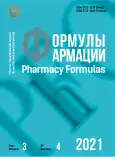Current issues in clinical trials of radiopharmaceutical drugs at the present stage of nuclear medicine development
- 作者: Efimov N.V.1, Lebedinets A..2
-
隶属关系:
- North-West Institute of Medical and Biological Problems and Environmental Protection Publishing House
- Leningrad Regional Clinical Oncological Dispensary named after L.D. Roman
- 期: 卷 3, 编号 4 (2021)
- 页面: 92-95
- 栏目: Actual problems: discussion tribune
- URL: https://journals.rcsi.science/PharmForm/article/view/106317
- DOI: https://doi.org/10.17816/phf106317
- ID: 106317
如何引用文章
全文:
详细
To date, doctors are becoming increasingly interested in radiopharmaceutical drugs associated with an improvement in their effectiveness and safety due to the use of alpha-emitting isotopes and highly selective ligands in the formulation. According to MarketsandMarkets, the nuclear medicine market will grow from $4.8 billion in 2021 to $7.5 billion by 2026 at a compound annual growth rate of 9%. The Russian Federation will have to work on import substitution with the analogue development of foreign-made drugs not registered in Russia, as well as original development that must meet world standards. Promotion of new drugs to patients is impossible without conducting clinical trials that meet GCP criteria. Even in countries with a high development of biomedical technologies, there are not enough resources to conduct clinical trials of new RPCDs. The most important limiting factors are the high cost of studies using open sources of radiation and the discrepancy between the traditional method of clinical trials, the unique properties of new RPCD and the effective method of theranostics using diagnostic and therapeutic pairs of radionuclides. To overcome these difficulties in evaluating RPCD, in particular, a phase zero clinical trial on several volunteers with the disease and the establishment of specialized testing clinical centers are proposed.
作者简介
Nikolay Efimov
North-West Institute of Medical and Biological Problems and Environmental Protection Publishing House
Email: nvef@rambler.ru
ORCID iD: 0000-0002-7703-0190
Doctor of Medicine (MD), Professor, Scientific Editor
俄罗斯联邦, Saint PetersburgAndrey Lebedinets
Leningrad Regional Clinical Oncological Dispensary named after L.D. Roman
编辑信件的主要联系方式.
Email: onco@lokod.ru
Ph.D. in Medicine, Head of the Department of Chemotherapy, Day Hospital
俄罗斯联邦, Leningrad region参考
- Federal’nyy zakon ot 12.04.2010 N 61-FZ «Ob obrashchenii lekarstvennykh sredstv» (poslednyaya redaktsiya) // Spravochno-pravovaya sistema “Konsul’tantPlyus”. URL: http://www.consultant.ru/document/cons_doc_LAW_99350/ (In Russ.).
- Egorova B. V., Fedorova O. A., Kalmykov S. N. Cationic radionuclides and ligands for targeted therapeutic radiopharmaceuticals. Russ Chem Rev. 2019;88(9):901–924.
- St James S., Bednarz B., Benedict S., et al. Current Status of Radiopharmaceutical Therapy. Int J Radiat Oncol Biol Phys. 2021;109(4):891–901.
- Turner J. H. Recent advances in theranostics and challenges for the future. Br J Radiol. 2018 ;91(1091):20170893.
- Poot A. J., Lam M. G. E. H, van Noesel M. M. The Current Status and Future Potential of Theranostics to Diagnose and Treat Childhood Cancer. Front Oncol. 2020;10:578286. https://doi.org/10.3389/fonc.2020.578286
- Kunos C. A., Rubinstein L. V., Capala J., et al. Phase 0 Radiopharmaceutical-Agent Clinical Development. Front Oncol. 2020;10:1310. https://doi.org/10.3389/fonc.2020.01310
- Alipour M., Baneshi M., Hosseinkhani S., et al. Recent progress in biomedical applications of RGD-based ligand: From precise cancer theranostics to biomaterial engineering: A systematic review. J Biomed Mater Res A. 2020;108(4):839–850. https://doi.org/10.1002/jbm.a.36862
- Kunos C. A., Mankoff D. A., Schultz M. K., et al. Radiopharmaceutical Chemistry and Drug Development-What’s Changed? Semin Radiat Oncol. 2021;31(1):3–11. https://doi.org/10.1016/j.semradonc.2020.07.006
补充文件







